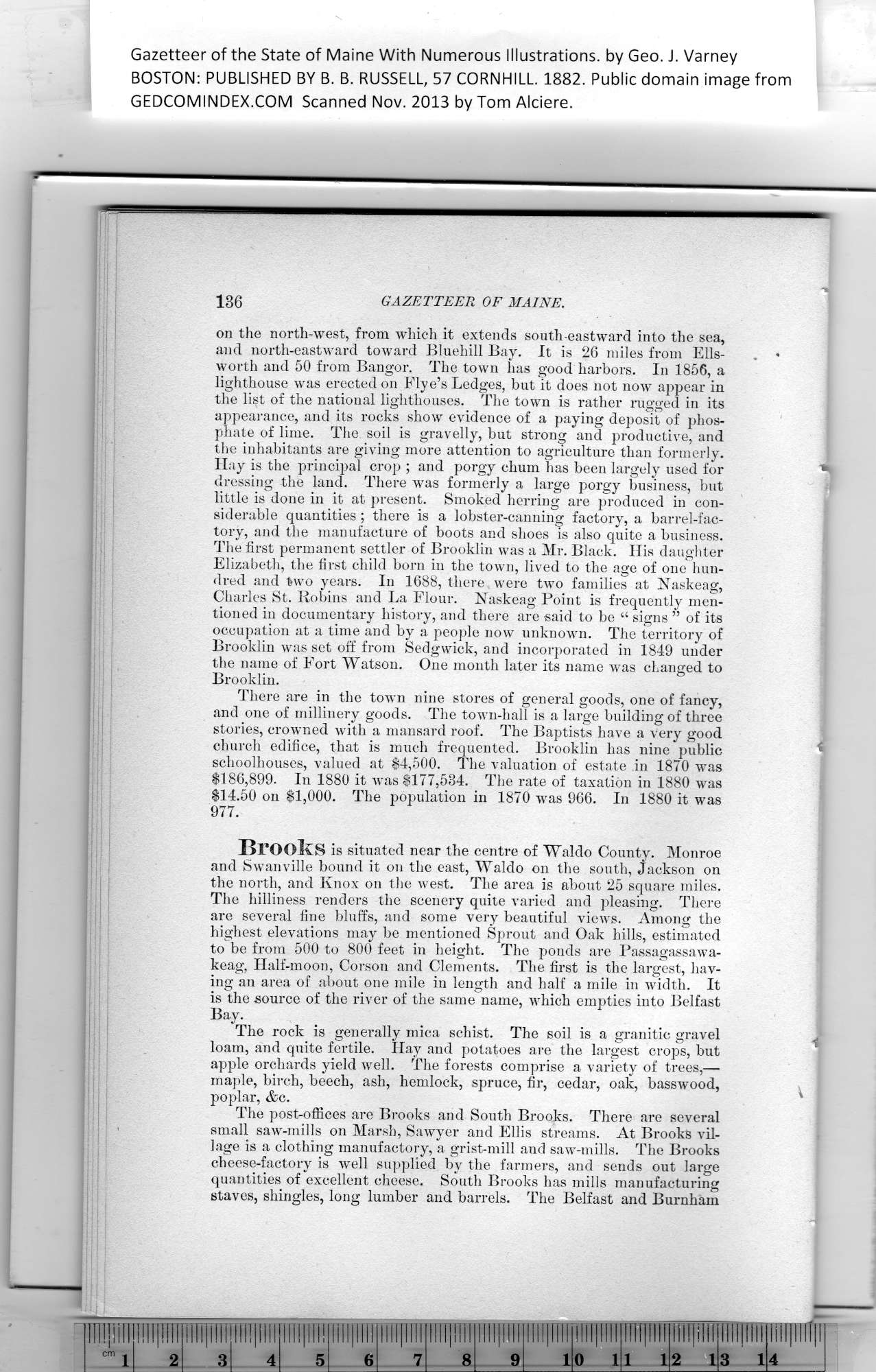|
Gazetteer of the State of Maine With Numerous Illustrations, by Geo. J. Varney
BOSTON: PUBLISHED BY B. B. RUSSELL, 57 CORNHILL. 1882. Public domain image from
136 GAZETTEER OF MAINE.
on the north-west, from which it extends south-eastward into the sea,
and north-eastward toward Bluehill Bay. It is 26 miles from Ells-
worth and 50 from Bangor. The town has good harbors. In 1856, a
lighthouse was erected on Flye’s Ledges, but it does not now appear in
the list of the national lighthouses. The town is rather rugged in its
appearance, and its rocks show evidence of a paying deposit of phos-
phate of lime. The soil is gravelly, but strong and productive, and
the inhabitants are giving more attention to agriculture than formerly.
Hay is the principal crop ; and porgy chum has been largely used for
dressing the land. There was formerly a large porgy business, but
little is done in it at present. Smoked herring are jn'odnced in con-
siderable quantities ; there is a lobster-canning factory, a barrel-fac-
tory, and the manufacture of boots and shoes is also quite a business.
The first permanent settler of Brooklin was a Mr. Black. His daughter
Elizabeth, the first child born in the town, lived to the age of one hun-
dred and two years. In 1688, there were two families at Naskeag,
Charles St. Robins and La Flour. Naskeag Point is frequently men-
tioned in documentary history, and there are said to be “ signs ” of its
occupation at a time and by a people now unknown. The territory of
Brooklin was set off from Sedgwick, and incorporated in 1849 under
the name of Fort Watson. One month later its name was changed to
Brooklin.
There are in the town nine stores of general goods, one of fancy,
and one of millinery goods. The town-hall is a large building of three
stories, crowned with a mansard roof. The Baptists have a very good
church edifice, that is much frequented. Brooklin has nine public
sehoolhouses, valued at $4,500. The valuation of estate in 1870 was
$186,899. In 1880 it w*as $177,534. The rate of taxation in 1880 was
$14.50 on $1,000. The population in 1870 was 966. In 1880 it was
977.
Brooks is situated near the centre of Waldo County. Monroe
and Swanville bound it on the east, Waldo on the south, Jackson on
the north, and Knox on the west. The area is about 25 square miles.
The hilliness renders the scenery quite varied and pleasing. There
are several fine bluffs, and some very beautiful views. Among the
highest elevations may be mentioned Sprout and Oak hills, estimated
to be from 500 to 800 feet in height. The ponds are Passagassawa-
keag, Half-moon, Corson and Clements. The first is the largest, hav-
ing an area of about one mile in length and half a mile in width. It
is the source of the river of the same name, which empties into Belfast
Bay.
The rock is generally mica schist. The soil is a granitic gravel
loam, and quite fertile. Hay and potatoes are the largest crops, but
apple orchards yield well. The forests comprise a variety of trees,—
maple, birch, beech, ash, hemlock, spruce, fir, cedar, oak, basswood,
poplar, &c.
The post-offices are Brooks and South Brooks. There are several
small saw-mills on Marsh, Sawyer and Ellis streams. At Brooks vil-
lage is a clothing manufactory, a grist-mill and saw-mills. The Brooks
cheese-factory is well supplied by the farmers, and sends out large
quantities of excellent cheese. South Brooks has mills manufacturing
staves, shingles, long lumber and barrels. The Belfast and Burnham
PREVIOUS PAGE ... NEXT PAGE
This page was written in HTML using a program written in Python 3.2
|
